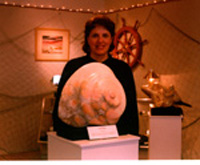 This interview took place with Jan Willing via email in early 2001. Once in a while you get an opportunity to meet a sculptor whose innate love and feel for the stone, combined with sheer joyful energy, just radiates. Jan is one such artist. Talking with her and sharing her thoughts was an energizing and fresh experience. Thank you, Jan for participating and giving us a glimpse into your magical world.
This interview took place with Jan Willing via email in early 2001. Once in a while you get an opportunity to meet a sculptor whose innate love and feel for the stone, combined with sheer joyful energy, just radiates. Jan is one such artist. Talking with her and sharing her thoughts was an energizing and fresh experience. Thank you, Jan for participating and giving us a glimpse into your magical world.
SS: Hi Jan, and thanks for doing this interview. I’d like to start by asking who the creative “Jan Willing” is and how you got your start with art?
JW: My first memory of being recognized as the creative one of the children in my family, was when my Grandma chose me from 10 grandkids to give her copy of World Famous Paintings edited by Rockwell Kent. She received it in 1941 and passed it on to me when I was 14, impressing on me her desire to have me pursue the arts. At the same age I received the book, my parents allowed me to take private oil painting lessons. That was a heady experience, but I have no idea where the resulting masterpieces are today.
By college, I was headed in an artistic direction, and went to Goucher College in Baltimore, Maryland, as a freshman and transferred to Scripps College in Claremont, California, for my sophomore year, where I signed up for a sculpture class with Aldo Casanova and fell in love. Not with him, although he was a very charismatic man as his name tells you, but with the process of stone sculpting. I spent a lot of time in the studio and would come back to my dorm room with dust all over me, look at the photos of the Pieta and other world famous pieces that I had taped to my walls, and cry. It was impossible to believe artists could do that fine, detailed lovely work - all with hand tools - and I could only make the most rudimentary of curves.  But I pursued because I loved the process. My professor left me alone for the most part. He would talk and gesticulate with all the other students, and I would continue to work on alone. We filled boxes with plaster then peeled the box off and carved the block. I did a stylized turtle shell. I then found where I could get real stone and bought a chunk of pink alabaster and two pieces of tan alabaster. The pink became a shell: Time Whorl, and won the Best of Show for the Claremont Colleges Art Show that year. We worked only in hand tools. My professor finally told me why he had left me alone all year. He said that I had natural abilities at sculpting and that he didn’t want to interfere with my development — that there was not a lot he could teach me! I was flattered at the time, but think I missed out on a remarkable relationship that could have taught me a lot.
But I pursued because I loved the process. My professor left me alone for the most part. He would talk and gesticulate with all the other students, and I would continue to work on alone. We filled boxes with plaster then peeled the box off and carved the block. I did a stylized turtle shell. I then found where I could get real stone and bought a chunk of pink alabaster and two pieces of tan alabaster. The pink became a shell: Time Whorl, and won the Best of Show for the Claremont Colleges Art Show that year. We worked only in hand tools. My professor finally told me why he had left me alone all year. He said that I had natural abilities at sculpting and that he didn’t want to interfere with my development — that there was not a lot he could teach me! I was flattered at the time, but think I missed out on a remarkable relationship that could have taught me a lot.
SS: After you graduated from college did you immediately embark on using your artistic talents?
JW: When I graduated from college I immediately went to work for Richard Runyon Design and then Chambers Design Group, both in Santa Monica, CA. We did a lot of graphic package design and corporate identity. I found that if I worked with color, shape, pens, ink, glues, type and paper all day, I didn’t have any creative energy left for myself at the end of the day. It was a fun and exciting world to be in, but the art was flat, and I did miss working three-dimensionally. Then I got married, moved to Boston and worked for Selame Design. These were all very well recognized firms and I got so I could walk through a grocery store and point to at least 30 product lines I had worked on. I worked on the FedEx identity, putting it on small plane models. I hand painted the numbers and symbols on the keys of the first hand held calculator models in the early 1970’s. I did Oroweat breads, Van de Kamps bakery and frozen food lines, Kern’s Jams and Jellies, several dairy lines, Laura Scudders potato chips...the list goes on and on. My husband finished college and we left Boston in 1979 and headed west, starting life over in Port Angeles. For three years I learned to garden, can food and chop wood. My creative energies went into these very grounding activities and it wasn’t until seven years after my year at Scripps that I was able to work in stone again.
SS: What led you to back to stone. How did you start up again?
JW: In 1983 I was freelance designing in Seattle and rented space at North Seattle Community College in the sculpture studio and spent time there between design jobs. I had almost a year working in stone before my son, Adam, was born. I loved it, but life got in the way and circumstances forced another 15 year break in stone work.
It didn’t seem likely that as a divorcee with an 8 year old and a 5 year old that I would ever have the luxury of working in stone again. But a wonderful man met us, wooed us and married us, partially drawn in by the sculptures that I had carted around with me since college and that were displayed in my home. A few years into our relationship, he brought home a smallish (5 x 11 x 3, 2 lb.) piece of soapstone that he had bought at a garage sale. He casually left it around, but I didn’t get the hint. Then I found a note on it: “I wonder what is inside this stone. Surely it’s more than a doorstop!”  So I messed with it using wood carving tools, and a howling dog emerged. I think I felt like that howling critter-whatever excitement, joy and angst is being expressed in that activity, that was what I felt working in stone again. I took a long time to do that piece, not having more stone to work on. Then, for my birthday, the kids dragged a gunny sack into the room, filled with soapstone pieces and two pieces of pink alabaster. Peter had found a supplier, and I was on a roll.
So I messed with it using wood carving tools, and a howling dog emerged. I think I felt like that howling critter-whatever excitement, joy and angst is being expressed in that activity, that was what I felt working in stone again. I took a long time to do that piece, not having more stone to work on. Then, for my birthday, the kids dragged a gunny sack into the room, filled with soapstone pieces and two pieces of pink alabaster. Peter had found a supplier, and I was on a roll.
SS: How did NWSSA become a part of your life?
JW: Well, that was three years ago. I had friends here in Bellingham who knew Michael Jacobsen and Ruth Mueseler, and of their stone sculpting work. I was introduced and was so nervous! Michael told me about the Camp Brotherhood Symposium and encouraged me to come to it. I picked up a brochure on it at the local art store. Then I called Michael and begged him to come to my house and look at the sculptures I had made, and tell me if I would be laughed off the farm if I did work up my courage and go to the Symposium. He was very kind, gentle and affirming. Of course, now I know that anyone would fit into the gang at the Symposium, that you wouldn’t have to have been a sculptor ever before in your life...but it was a HUGE deal that first year for me. I was in a stew for months beforehand, but I signed up for all 10 days and brought my wiki-up shelter which seems to have been a big hit.
Now I have been at three Camp Brotherhood Symposia and I always seem to start an amazing piece there. I haven’t taken a lot of classes, mostly because I get so energized working on my piece that I don’t want to be off the field.
SS: Your energy is amazing! How many sculptures have you completed? And how is your art career coming along?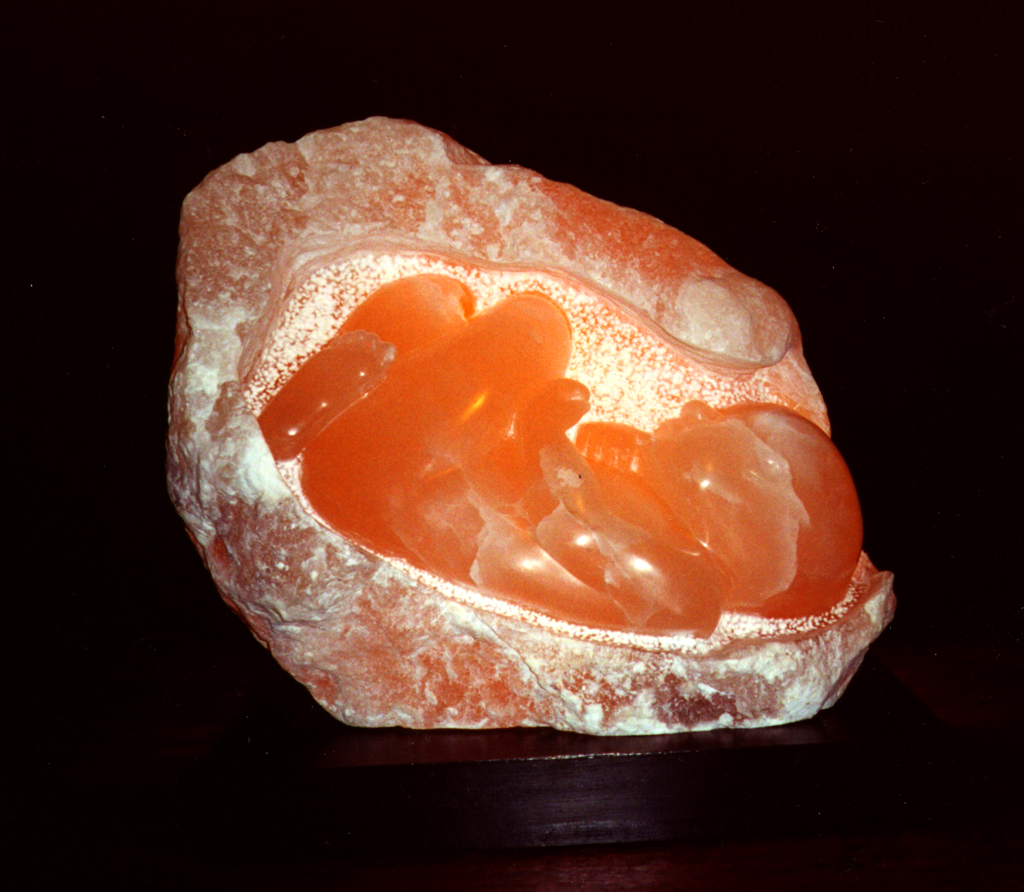 JW: I have now completed close to 40 stone sculptures, and sold several, in spite of my reluctance to market them. One was from the first symposium, the white alabaster piece that had the gray rind on one side. It was called “Secrets to the Moon” and depicted a small boy, floating in clouds, whispering secrets to a moon, a moon whose face was modeled on David Edwards, by the way. I brought the unfinished piece home and completed it, and then heard through the grapevine that a lady was very interested in it. Two and a half years later, this lady still remembered the piece and talked to her local sculptor, Verena Schwippert, about it. I was called, told of the interest, and brought the piece down to Verena’s to show the lady. She had remembered it so long because it reminded her of her son, who had always been a dreamer and a high flyer. For a profession he sets up the high wiring and lighting for stage work in Las Vegas. So she had her husband and son purchase it for her for Mother’s Day last year. That was really special and unexpected, and is how I like to sell my art: to someone who has a very special interest and connection to a piece that I have done. Just before Christmas last year, a gallery owner who has some of my pieces called me. She had a customer who liked my work, but just didn’t find the right piece in her gallery. They came to the house, he looked over the pieces here, fell in love with the soapstone of the howling dog (“The Howl”). It was perfect for his mother in Georgia who is a wolf enthusiast and a geologist. So away it went.
JW: I have now completed close to 40 stone sculptures, and sold several, in spite of my reluctance to market them. One was from the first symposium, the white alabaster piece that had the gray rind on one side. It was called “Secrets to the Moon” and depicted a small boy, floating in clouds, whispering secrets to a moon, a moon whose face was modeled on David Edwards, by the way. I brought the unfinished piece home and completed it, and then heard through the grapevine that a lady was very interested in it. Two and a half years later, this lady still remembered the piece and talked to her local sculptor, Verena Schwippert, about it. I was called, told of the interest, and brought the piece down to Verena’s to show the lady. She had remembered it so long because it reminded her of her son, who had always been a dreamer and a high flyer. For a profession he sets up the high wiring and lighting for stage work in Las Vegas. So she had her husband and son purchase it for her for Mother’s Day last year. That was really special and unexpected, and is how I like to sell my art: to someone who has a very special interest and connection to a piece that I have done. Just before Christmas last year, a gallery owner who has some of my pieces called me. She had a customer who liked my work, but just didn’t find the right piece in her gallery. They came to the house, he looked over the pieces here, fell in love with the soapstone of the howling dog (“The Howl”). It was perfect for his mother in Georgia who is a wolf enthusiast and a geologist. So away it went.
SS: Jan, how do you approach your stone carving? Is there a particular method you use?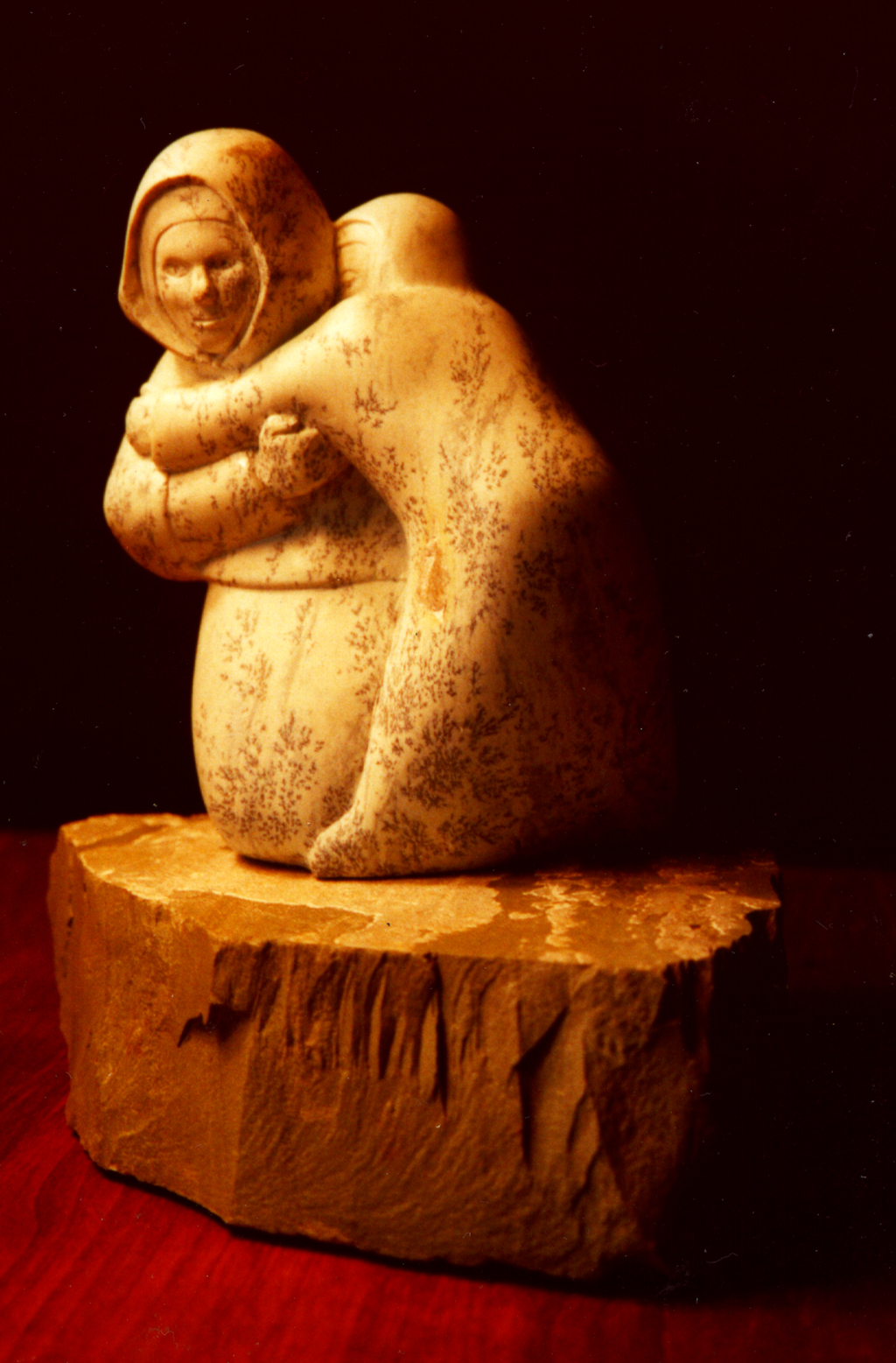 JW: I am a direct carver. I set the chosen stone up on my work table and get to know it. I look at it, turn it, daydream on it. I take hand tools and begin to work around the edges of it. I remove obvious punky stone, check for cracks, smooth out curves. I always wonder if I will just end up with a pile of rubble doing this; that inspiration or intuition will never hit me. But it always has. One great example is the piece that I did at Brotherhood last summer. Shortly after I arrived, I was looking at the stones on the tarmac and in the bottom of one bin, was a stone that just glowed. It was a hunk of translucent white alabaster from Italy and it was gorgeous. It had its own inner light and although I waffled about the price, I knew I wanted it. With encouragement from Peter, I went ahead and bought it, had it put up on my work table and stood admiring it. Just in itself, without my participation at all, it was beautiful. As I watched, a little foot poked out, then a shoulder, then a head. The baby of “Crowning Moment” was there waiting for me to peel away the amniotic stone that held it. I didn’t attend one class while I was there. I just worked on this baby. I opened the geode-shaped rock and released it. This was an amazing experience because I had no photos of babies to work from, just my memories and the help of several people from camp. I am really proud of how it turned out, though never have I sanded so much on a piece before in my life. This stone is translucent through even it’s thickest point, about 12”, and I had to go to 1600 wet/dry sandpaper to get all the marks off the baby’s skin. You can shine light completely through it.
JW: I am a direct carver. I set the chosen stone up on my work table and get to know it. I look at it, turn it, daydream on it. I take hand tools and begin to work around the edges of it. I remove obvious punky stone, check for cracks, smooth out curves. I always wonder if I will just end up with a pile of rubble doing this; that inspiration or intuition will never hit me. But it always has. One great example is the piece that I did at Brotherhood last summer. Shortly after I arrived, I was looking at the stones on the tarmac and in the bottom of one bin, was a stone that just glowed. It was a hunk of translucent white alabaster from Italy and it was gorgeous. It had its own inner light and although I waffled about the price, I knew I wanted it. With encouragement from Peter, I went ahead and bought it, had it put up on my work table and stood admiring it. Just in itself, without my participation at all, it was beautiful. As I watched, a little foot poked out, then a shoulder, then a head. The baby of “Crowning Moment” was there waiting for me to peel away the amniotic stone that held it. I didn’t attend one class while I was there. I just worked on this baby. I opened the geode-shaped rock and released it. This was an amazing experience because I had no photos of babies to work from, just my memories and the help of several people from camp. I am really proud of how it turned out, though never have I sanded so much on a piece before in my life. This stone is translucent through even it’s thickest point, about 12”, and I had to go to 1600 wet/dry sandpaper to get all the marks off the baby’s skin. You can shine light completely through it.
SS: I get the feeling that you have a very emotional and spirtual connection with the stone. Is this constant for you when you work?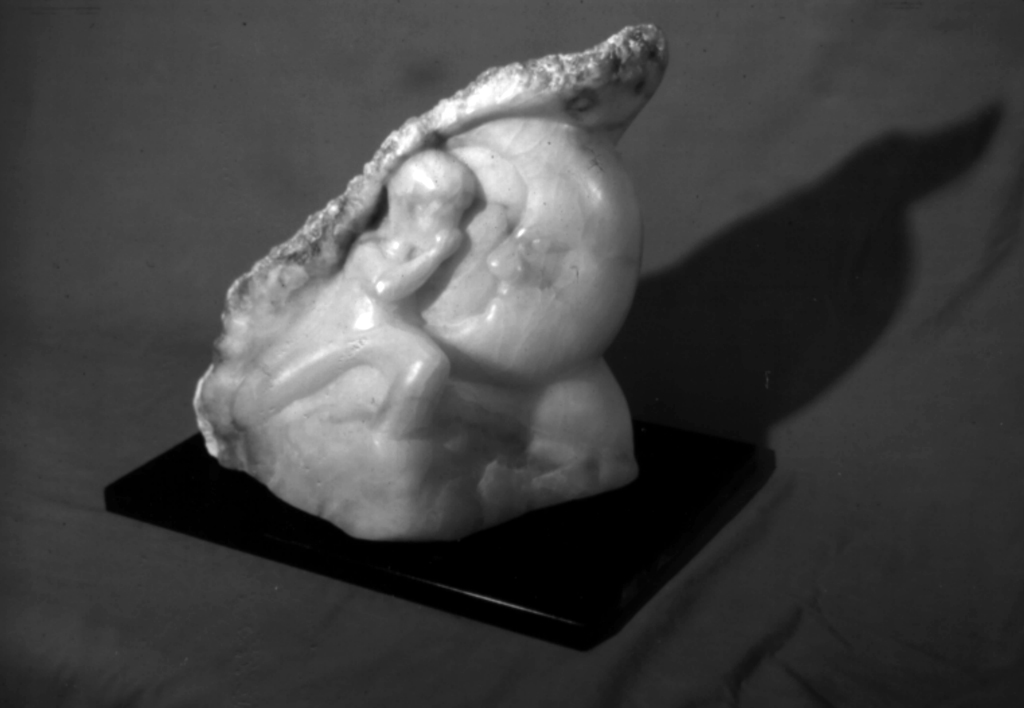 JW: Being led and directed by the stone makes being a stone sculptor a transcendental experience. Approaching the stone with the knowledge that it knows what it is, releases me from figuring it out and challenges me to listen, see into, and learn the stone’s desire. Sometimes I argue with it (You ARE a polar bear./I’m NOT. I’m a white rabbit!), thinking I know better, but it argues back and always wins.
JW: Being led and directed by the stone makes being a stone sculptor a transcendental experience. Approaching the stone with the knowledge that it knows what it is, releases me from figuring it out and challenges me to listen, see into, and learn the stone’s desire. Sometimes I argue with it (You ARE a polar bear./I’m NOT. I’m a white rabbit!), thinking I know better, but it argues back and always wins.
SS: Does this affect the sculptures that you carve? Does this help define your “style”?
JW: Because of working in this way, my pieces are all different. I don’t have an established style that I can discern as being distinctly mine. Many of the pieces have personal significance in my life. They came with a message for me as I worked on them, one that helped me understand a situation or a philosophical question better. I enjoy this aspect of my art tremendously. Some examples of this: a pink alabaster mermaid emerging from a shell (“Aphrodite Emerging”). Well, that was me. 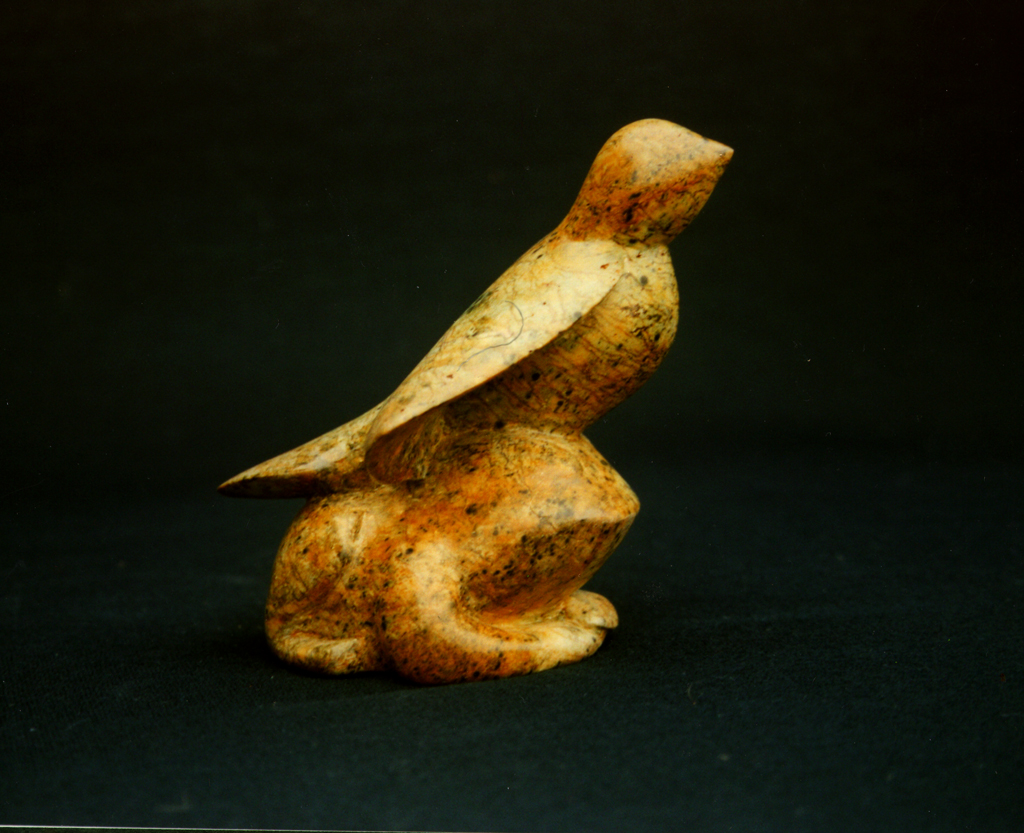 Coming out as an artist, as it were, after many years of denying myself. I did a small soapstone piece that is a bird with his wings around a frog, and the frog is holding onto the wings. I kept wondering as I was doing it, what is this about? And the answer came, the bird wishes he could swim and the frog wishes he could fly. Between them they hold the entire world. Be happy where you are and make the most of it. Most of my pieces are done while this kind of meditative internal conversation is going on, and it always surprises and delights me that many of the pieces come with a story.
Coming out as an artist, as it were, after many years of denying myself. I did a small soapstone piece that is a bird with his wings around a frog, and the frog is holding onto the wings. I kept wondering as I was doing it, what is this about? And the answer came, the bird wishes he could swim and the frog wishes he could fly. Between them they hold the entire world. Be happy where you are and make the most of it. Most of my pieces are done while this kind of meditative internal conversation is going on, and it always surprises and delights me that many of the pieces come with a story.
SS: Have you had many successes in showing your work?
JW: I have been very fortunate. My first show was a one-woman show at the Pacific Marine Gallery in Bellingham! What a rush. What an entry into the world of showing your artwork! Having my name up on the marquee outside was an epiphany for me. I felt that I could no longer be so casual about my work, after all, the world was watching.
SS: Can you tell me a little about the stones you prefer to carve, and how you work them?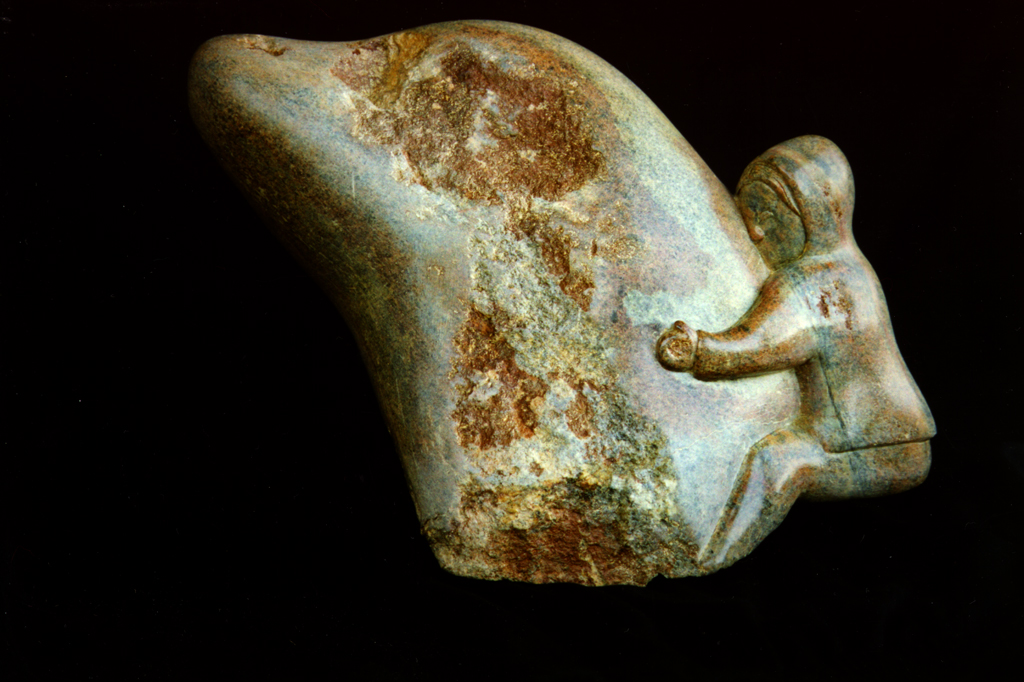 JW: The largest stone I have worked on is a 200 lb. chunk of Carrara marble, but mostly I work on stones that I can wrestle around myself. I work in the softer stones because I use mainly hand tools. One year for Mother’s Day I received a Foredom, and it definitely beat getting a toaster! I use it a lot, but haven’t graduated to an angle grinder yet. I keep thinking that so much of the experience for me is the connection between my body, my hands, and the stone. The pace of my creative vision doesn’t seem to be fast enough to keep up with a grinder. I am a cloud gazer. I spend quite a bit of time watching clouds and being amazed at how they change from a rabbit to a bear to an elephant to a boy riding a wolf. That is the pace I like to work at in stone. My pieces come clearly to me when every 1/32 of an inch that comes off tells a different story. I am not sure you can get that with big blades, but perhaps I am just not there yet.
JW: The largest stone I have worked on is a 200 lb. chunk of Carrara marble, but mostly I work on stones that I can wrestle around myself. I work in the softer stones because I use mainly hand tools. One year for Mother’s Day I received a Foredom, and it definitely beat getting a toaster! I use it a lot, but haven’t graduated to an angle grinder yet. I keep thinking that so much of the experience for me is the connection between my body, my hands, and the stone. The pace of my creative vision doesn’t seem to be fast enough to keep up with a grinder. I am a cloud gazer. I spend quite a bit of time watching clouds and being amazed at how they change from a rabbit to a bear to an elephant to a boy riding a wolf. That is the pace I like to work at in stone. My pieces come clearly to me when every 1/32 of an inch that comes off tells a different story. I am not sure you can get that with big blades, but perhaps I am just not there yet.
SS: What’s your work environment like?
JW: I work in a small studio in my basement that has clear plastic walls and a fan to suck dust away. In summer I often work outside. My arrangements are not very formal o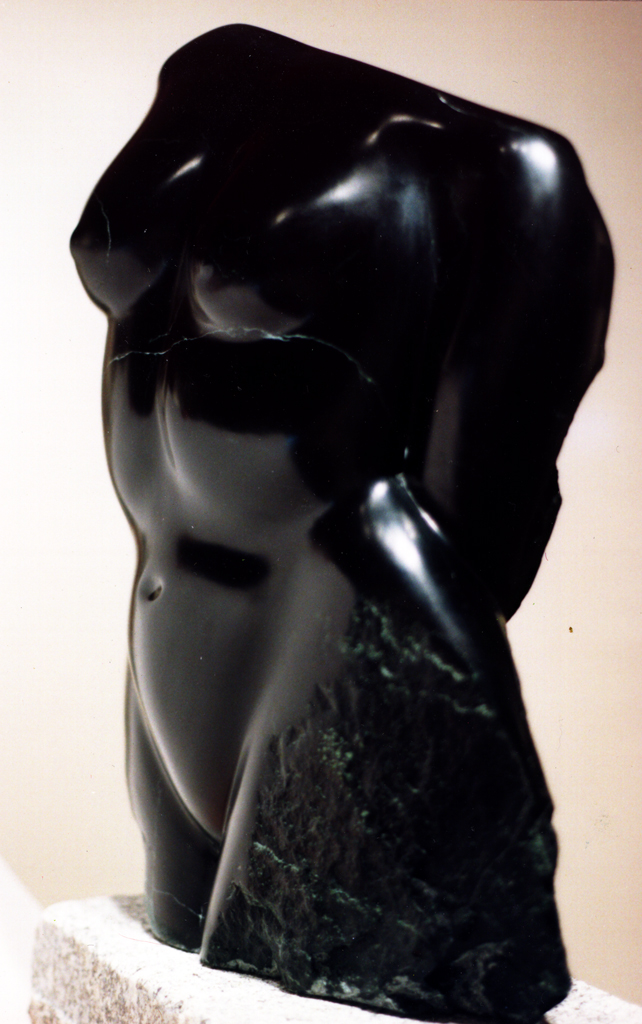 r very sophisticated, and I am quite happy with them. I seem to work in widely spaced intervals — sometimes a lot and sometimes not at all. My family is tremendously supportive. Peter will do anything to support this interest — including bringing me to Brotherhood, setting me up and returning to take down and escort me home. It is always a challenge for me to leave home. We still have two teenagers and all the joys that go with that process, and I garden a lot during the spring, summer and fall. We have a sailboat that takes us to quiet, dark nights and glorious bird watching days. So my life is full of all kinds of stimulation, impressions and situations that feed my creative holding tank until I can spend time with a stone.
r very sophisticated, and I am quite happy with them. I seem to work in widely spaced intervals — sometimes a lot and sometimes not at all. My family is tremendously supportive. Peter will do anything to support this interest — including bringing me to Brotherhood, setting me up and returning to take down and escort me home. It is always a challenge for me to leave home. We still have two teenagers and all the joys that go with that process, and I garden a lot during the spring, summer and fall. We have a sailboat that takes us to quiet, dark nights and glorious bird watching days. So my life is full of all kinds of stimulation, impressions and situations that feed my creative holding tank until I can spend time with a stone.
SS: How has NWSSA affected your art work and your life?
JW: I feel I owe a great deal to NWSSA and its members. The Camp Brotherhood experience has been very instrumental in my continuing to sculpt at this time in my life. Having the support of incredibly talented people who give advice, encouragement and friendship is an amazing experience. Where else would I find a Sabah or a Terry or a Michael or a June or a Nicky or a Pat to help me over rough spots? And out of my Brotherhood experience has come some marvelous opportunities to display my work in different shows, and then to co-curate the Allied Arts show in Bellingham with Scott Emory. One thing seems to lead to another and another and another and I am very interested to see where it will lead me in the future.

